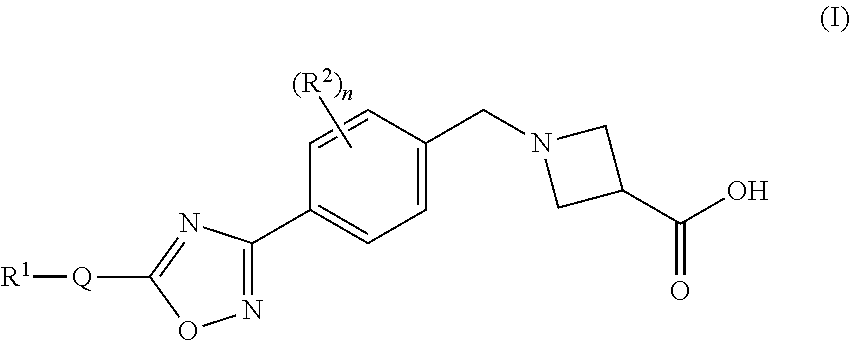Substituted heterocyclic compounds
a heterocyclic compound and substituent technology, applied in the field of heterocyclic compounds, can solve the problems of inconvenient use, inability to meet the needs of patients,
- Summary
- Abstract
- Description
- Claims
- Application Information
AI Technical Summary
Benefits of technology
Problems solved by technology
Method used
Image
Examples
example 1
1-(4-(5-(3-(Pyridin-2-yl)-4-(trifluoromethyl)isoxazol-5-yl)-1,2,4-oxadiazol-3-yl)benzyl)azetidine-3-carboxylic acid
[0184]
1-A. N-Hydroxypicolinimidoyl chloride
[0185]
[0186]To a colorless, homogeneous solution of (E)-picolinaldehyde oxime (6.75 g, 55.3 mmol) in N,N-dimethylformamide (55 mL) at room temperature was added N-chlorosuccinimide (7.38 g, 55.3 mmol) portion-wise. After the addition of ˜⅕ of the NCS, the reaction mixture was immersed in an oil bath at 60° C., and the remaining NCS was added portion-wise over 1.5 h. After the addition was complete, the homogeneous reaction mixture was stirred for 60 min. at 60° C. and was then cooled to room temperature. Water (400 mL) was added, and the aqueous mixture was extracted with ether (3×200 mL). The organic layer was collected, washed with water (2×200 mL), washed with a saturated aqueous solution of brine (100 mL), and dried over anhydrous magnesium sulfate. Concentration under reduced pressure afforded N-hydroxypicolinimidoyl chlor...
example 2
1-(4-(5-(5-(Pyridin-2-yl)-4-(trifluoromethyl)isoxazol-3-yl)-1,2,4-oxadiazol-3-yl)benzyl)azetidine-3-carboxylic acid
[0217]
2-A. 5-(Tributylstannyl)isoxazole-3-carboxylate
[0218]
[0219]An oven dried 500 mL round bottom flask equipped with a stir bar was cooled under a stream of dry nitrogen. Ethyl chlorooximidoacetate (4.95 g, 32.7 mmol), diethyl ether (100 mL), and tributyl(ethynyl)tin (9.45 mL, 32.7 mmol) were added to give a clear pale yellow solution. Triethylamine (6.83 mL, 49.0 mmol) was added dropwise via syringe. After ˜500 μL had been added, the solution became cloudy. After the addition of ˜2 mL, the solution began to boil, so a cold water bath was introduced and the rate of addition was slowed. The triethylamine was added slowly over 10 minutes to give a pale yellow suspension which was stirred at room temperature overnight. The solution was cooled using a dry-ice bath, filtered cold, and rinsed with cold diethyl ether. The filtrate was evaporated and placed under high vacuum ...
example 3
1-(4-(5-(4-Propyl-5-(pyridin-2-yl)isoxazol-3-yl)-1,2,4-oxadiazol-3-yl)benzyl)azetidine-3-carboxylic acid, 2,2,2-trifluoroacetic acid salt
[0235]
3-A. 2-(Pent-1-ynyl)pyridine
[0236]
[0237]To a degassed solution of 2-iodopyridine (0.519 mL, 4.88 mmol), bis(triphenylphosphine)palladium(II) chloride (0.205 g, 0.293 mmol), copper(I) iodide (0.046 g, 0.244 mmol), and diisopropylamine (2.78 mL, 19.5 mmol) in N,N-dimethylformamide (20 mL) was added 1-pentyne (0.721 mL, 7.32 mmol). The reaction was heated to 85° C. for 3 hrs. The reaction mixture was cooled to room temperature, diluted with ethyl acetate (150 mL), washed with a 10% aqueous solution of lithium chloride (2×100 mL), washed with a 2M aqueous solution of ammonium hydroxide (100 mL), washed with brine (100 mL), and dried over anhydrous sodium sulfate. Concentration followed by purification by silica gel chromatography with hexanes / ethyl acetate (3 / 2) afforded 2-(pent-1-ynyl)pyridine (636 mg, 4.31 mmol). The compound had an HPLC retent...
PUM
| Property | Measurement | Unit |
|---|---|---|
| temperature | aaaaa | aaaaa |
| HPLC retention time | aaaaa | aaaaa |
| temperature | aaaaa | aaaaa |
Abstract
Description
Claims
Application Information
 Login to View More
Login to View More - R&D
- Intellectual Property
- Life Sciences
- Materials
- Tech Scout
- Unparalleled Data Quality
- Higher Quality Content
- 60% Fewer Hallucinations
Browse by: Latest US Patents, China's latest patents, Technical Efficacy Thesaurus, Application Domain, Technology Topic, Popular Technical Reports.
© 2025 PatSnap. All rights reserved.Legal|Privacy policy|Modern Slavery Act Transparency Statement|Sitemap|About US| Contact US: help@patsnap.com



